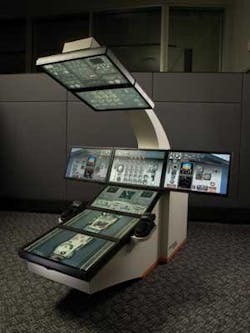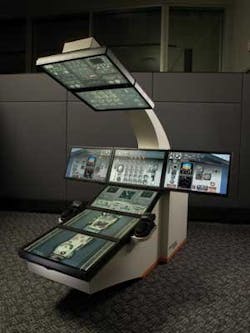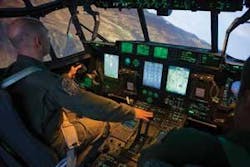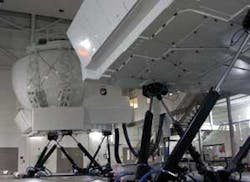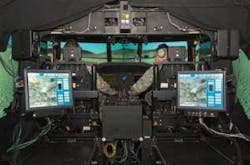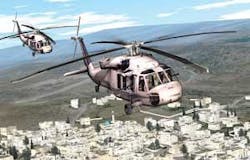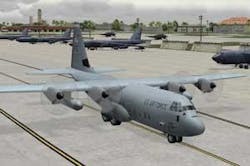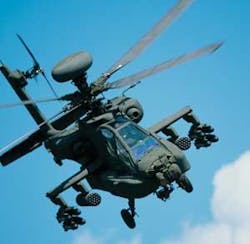High-fidelity COTS technology drives flight simulation
Designers of flight training and simulation systems for military and commercial aviation depend on commercial off-the-shelf (COTS) technology and common standards to create high-fidelity solutions.
ByJohn McHale
Train like you fight is the popular motto within U.S. military training commands. Enemies and threats continue to evolve around the world demanding that warfighters prepare for battle faster and more realistically than ever before.
High-fidelity simulation systems that duplicate real-world environments are necessary to help pilots and warfighters prepare for any situation from refueling in mid-air to avoiding runway incursions to engaging in air-to-air combat.
To create these synthetic environments, system designers are leveraging technology from the video and computer gaming worlds to form high-fidelity systems that provide unmatched realism.
“We’re seeing the level of realism increasing,” says Robert Kopersiewich, vice president of product management and business development at Presagis in Montreal. If one looks back in time just a few years, the difference in realism is dramatic, he adds.
U.S. Department of Defense (DOD) officials like enhanced realism in simulation not just for the capability, but also for the costs savings, Kopersiewich says. As simulators and trainers become more realistic there will be less need for expensive live training of pilots, he explains.
Fidelity in simulators is “20 times what it was only 10 years ago,” says Phillip Perey technical director at CAE in Montreal. CAE is the parent company of Presagis. Today’s systems replicate weather patterns, vehicle and aircraft movements, human behavior, etc., thanks to commercially available tools and commercial standards, Kopersiewich says.
Helicopter simulators are an excellent example of the increased fidelity, Kopersiewich says. Today’s systems can show the wind generated by a helicopter blade blowing leaves blowing on trees, he adds.
However, to create a true, complete real-world environment in every simulator is still not feasible because of the computer cost, Kopersiewich says. Mobile trainers may have fewer synthetic elements in the system than a full simulator but the fidelity of even portable desktop simulators is 10 times better than anything from a decade ago, he notes.
Military vs. commercial flight simulators
High fidelity is in demand for commercial and military simulators, Kopersiewich says. The only difference in military simulation is the need to simulate the sensor suites such as video, infrared, etc., he adds.
At CAE, it is often said that “commercial flight simulators teach you to fly while military flight simulators teach you to fly while someone shoots at you,” Perey says. Military simulators tend be more complex due to the need for combat training, which means factoring enemy aircraft, ground -to-air defenses, and more complex sensor environments and missions, such as searching for improvised explosive devices (IEDs), he adds.
Military simulators are not just for flight training, but also to train on weapons and engage targets or even do search and rescue, says Kevin Hines, principal engineer at Rockwell Collins Simulation and Training in Sterling, Va.
COTS and standards
Today’s flight simulators create these environments by using technology standards and commercial off-the-shelf (COTS) hardware and software, which also helps keep costs down, Hines says. Simulators and trainers 10 or 20 years ago were proprietary, expensive, and designed in house with custom components and using proprietary databases, Perey says.
Using COTS technology not only brings in higher fidelity but also lowers the cost of the overall system because they are typically using open standards, Kopersiewich says. The barrier to entry has been lower throughout the industry due to the use of COTS, he adds.
Presagis makes a variety of off-the-shelf solutions, such as: Vega Prime for creating 3D simulations; Terra Vista for generating terrain; CREATOR for 3D modeling; STAGE for generating scenarios, and Lyra for image generation, Kopersiewich says.
Presagis tools helped develop the Boeing Apache AH-64D helicopter simulator, Kopersiewich says. Boeing used the company’s Lyra image generator in its new Block III Apache Engineering Development Simulator (EDS), the virtual simulation of the Apache weapon system including night vision, weather, and rotor effects.
It is also important that simulators and trainers be able to work across several computing platforms, and even be transportable to the field, Hines says.
At Rockwell Collins, engineers designed a portable system called the Transportable Black Hawk Operations Simulator (T-BOS), that can be deployed directly to the field and installed in only a few hours, he continues. The system is easily maintained with a modular architecture that allows operators or technicians to just swap components out as they go obsolete, he adds.
Rockwell Collins CORE
Hines says open architecture and commonality across simulation platforms drove Rockwell Collins to create its CORE architecture for simulation. The objective is to have a modular architecture based on open standards that can run on real-time operating systems or on a rugged laptop that uses Windows and Linux, he adds.
When using COTS, it is important for the software to be independent of the hardware so that when components go obsolete or software needs to be re-used in other systems, it can be done without creating the system from scratch, Hines adds.
The CORE software and tools can be scaled for different simulations and computer platforms combined with the avionics displays and hardware Rockwell Collins uses for simulators and actual aircraft cockpits, Hines says.
The image generation technology for CORE comes from the Rockwell Collins acquisition of Evans and Sutherland in 2006, Hines notes. The company’s Virtual Avionics Procedure Trainer (VAPT) is based on the CORE architecture, he says. The VAPT uses the classroom method, it is not a full simulator, Hines says.
More and more desktop simulators are used in the classroom environment to get pilots familiar with cockpit functionality early in their training so they are more prepared when they move to a full flight simulator, Hines says. This also cuts down on training time, he adds.
The VAPT is used by the U.S. Air Force to train Iraqi pilots flying King Air aircraft for intelligence, surveillance, and reconnaissance (ISR) missions according to a Rockwell Collins release. A team of Air Force and Navy Combat air advisors provides pilot and mission system operator training to the Iraqi Air Force on newly acquired King ISR aircraft.
A challenge the advisors are facing is converting the Iraqi pilots’ previous knowledge of the older MiG jet technology to the state-of-the-art systems used on the King Air, according to the release.
“During its first week of operation, the VAPT has been embraced by the pilots of Iraqi Air Force King Air Squadron 87,” says U.S. Navy Capt. Scott Seeberger, commander of the King Air 350 Military Training Team. “The squadron’s senior qualified pilots are already using the device to teach those junior to them on the complex operation of the aircraft flight management and autoflight system. Rockwell Collins did an outstanding job providing detailed instruction on the VAPT operation to U.S. Combat Air Advisors and Iraqi King Air pilots.”
Rockwell’s common CORE architecture is used for both military and commercial aviation simulators, Hines notes.
Standard databases
Using common databases is just as important as using commercial standards for managing costs in simulation development. In the past, training systems would have incompatible databases, CAE’s Perey says. Pilots would train on one simulator that would have them flying over a mountainous region and have a target just be out of sight behind the mountain, he continues. Six months later, they could be training on a different simulator, flying over the same terrain but without the mountains, because that simulator was not compatible with the previous terrain database, Perey explains.
Correlating these proprietary databases in one system could also be quite difficult, Perey says. There were proprietary databases for not just terrain but radar and weather, he adds. Today, there are many standard databases that several developers and users can access, such as the Geographic Information Systems (GIS) database, Perey notes.
Along those lines, CAE engineers created what they call the Common Database (CDB), which solves many of those problems for the end user by creating a standard world for him to develop his system in, Perey says. CDB enables the end user to have the “synthetic environment as rich and compelling as he would like it to be,” he adds.
It was created for U.S. Special Forces combat mission simulators–a MH-47G Chinook helicopter simulator and a MH-60: Black Hawk helicopter simulator, Perey says.
Perey referenced the CAE product brochure on CDB which states that CDB “is a single, standard database that defines a single synthetic representation of the world, and all simulation systems use the same database–the CDB. The CDB is used as a run-time data repository from which the various simulation clients simultaneously retrieve relevant information to perform their respective run-time simulation tasks.”
According to the CDB brochure, it eliminates source correlation errors between simulation subsystems, which helps reduce development time and cost. It also mostly “eliminates the time-consuming, off-line database compilation process for each of the simulation clients. Current compilation steps lead to the replication of data and to a loss of correlation across the simulator network.
CAE’s database balances “off-line and online compilation processes” because it uses high-performance computer systems to complete most of the compilation process in real time, according to the brochure. The CDB provides a single “repository consisting of a static synthetic representation ranging from small areas of interest to the entire world.”
According to the brochure, the CDB also performs rapid database updates and always uses unique database content that is never duplicated. “We feel the DCB has the potential to go beyond training,” Perey says. It brings the simulation environment right to the battlefield in Afghanistan or Iraq where it can help military users develop specific mission scenarios for changing threats, he continues. For example, it can now integrate real-time intelligence data from the field so that pilots can train on it or review it before they go on their missions the next day, Perey says.
Users can run the software on different platforms, such as a rugged laptop that uses Windows, Perey adds.
CAE’s CDB is also used on trainers for the U.S. Air Force C-130J and the U.S. Navy P-3 aircraft, Perey notes.
Boeing Apache Longbow simulators
Engineers working on the U.S. Army Apache Longbow program at Boeing Integrated Defense Systems in Mesa, Ariz., use simulators not just to train the pilots but themselves as well.
When first trying out new technologies, Boeing engineers will use the Advanced Rotorcraft Rapid Prototyping Mission Simulator, says Mike Wolf, embedded software engineer for Apache Longbow Simulation at Boeing. Once technologies are proved there, they move into the Apache Engineering Development Simulator (EDS)–where all fight hardware and software are tested, he adds.
Pilots and other aircrew use the EDS as well, Wolf says. There are also Boeing Apache portable trainers that are sent to the field or used by pilots for flight training, he continues.
The main difference between a trainer or the Rapid Prototyping Simulator and a full flight simulator is that the full flight simulator must use as much of the actual cockpit electronics that are in the real aircraft, Wolf says. This means less use of commercial off-the-shelf (COTS) technology, he adds.
The Apache mission computer is “ABC–anything but COTS,” Wolf notes. “We use COTS to stimulate certain components that cannot be replicated, such as the forward-looking infrared sensors (FLIRs).”
Wolf demonstrated a version of the Rapid Prototyping Simulator at the Association of the U.S. Army’s (AUSA’s) Annual Meeting last month. Highlighting that demonstration was voice-command recognition technology.
Wolf says this will enable pilots to fly without having to press buttons or spend excess time reading displays. It brings the pilots out of the cockpit, so to speak, says Jeffrey Shelton, former Apache pilot and domestic rotorcraft business development manager at Boeing. Once the voice-recognition technology is ready to be deployed, it will enable pilots to keep their eyes out the window and their hands on the flight controls, he adds.
Voice commands also come in handy when performing secure communications, Wolf says. Currently, the Apache pilot must press a series of buttons to get a secure communication line, with voice control he will be able to do it with a spoken phrase in seconds, he adds.
Wolf says that this technology is not yet even ready for the EDS. The pilots love the concept, but there are still issues to be worked out such as noise interference–the Apache cockpit is not exactly quiet, he notes.
So far, the system recognizes voice commands with about 90 percent accuracy, Wolf says. Boeing officials would like to improve the accuracy a bit more and expand the capability–vocabulary–of the system before moving it to the EDS, he adds.
Also during AUSA, Wolf demonstrated “context-sensitive menuing”–in other words, a touch screen that enables the user to click and drag objects and to access drop-down menus by using his finger like a mouse, he says. If either the voice recognition or the menuing get integrated into actual Apache aircraft depends on funding more than anything else, Wolf says. Boeing funded the development of the technology internally, but to see it move into the Apaches it will need Army approval, he adds.
After avionics technology is proven on the Rapid Prototyping Simulator, it would move to the EDS for more extensive training. Wolf references an Apache brochure for EDS statistics during the Apache Block III System Design and Development Phase. According to the brochure: The EDS found and fixed 25 mission processor software issues; made 34 Instrument metrological condition/instrument flight rule design inputs; and made 88 UAS design comments/improvements.
“The Apache Block III EDS has demonstrated repeatedly that early integration, testing, and user assessment finds 95 percent of the operational issues that would otherwise be defects found in flight test,” Bruce Hamilton, senior manager of Boeing’s Crew Systems & Human Factors Department, says in the brochure. “The significant reduction in rework costs always offsets the cost of early EDS assessment. The ‘magic’ that makes this happen is requirements validation and early customer buy-in. For the same overall cost, investment in early EDS protects the delivery schedule of the tested and proven product.”
The EDS was also used to demonstrate the Apache Block III’s unmanned aerial vehicle (UAV) Level IV capability, Wolf says. Level IV enables the Apache aircrew to control the navigation for UAVs, as well as see what it sees in real time, he adds.
Also unlike VUIT-2–Apache Video from Unmanned Aircraft Systems for Interoperability Teaming–Level 2 (VUIT-2), it is an original part of the avionics and not added on, Wolf says. VUIT-2 provided Level II UAV capability, which received UAV imagery, but could not transmit it out, he adds.
In addition, Boeing designs portable Apache Longbow Crew Trainers for the Army. According to a Boeing release, the trainers use Boeing software technologies: Next Generation Flight Model (NGFM) and Common Simulation Framework (CSF).
According to the release, the “NGFM software, which improves the trainer’s realism, incorporates actual aircraft flight-test data. The CSF combines tools for software development, testing, and systems integration with reusable software packages, ensuring faster, easier development of trainer software.”
This Apache trainer, which provides training for individuals, aircrews, and maintenance test pilots, uses image-generator technology that allows for the display of more realistic out-the-window scenes in real time, according to the release. The Apache trainers have been deployed to troops in Iraq and Afghanistan.
Military flight simulation market growing strong
Leaders at flight simulation and training company CAE say that while commercial flight simulator orders have slowed, the military demand continues to increase.
The military flight simulation market continues to look positive, says Phillip Perey, technical director at CAE in Montreal. There is tremendous pressure to cut down on live training costs and have pilots spend more time in simulators to train to fly and fight, he adds. The military is going to spend billions of dollars on simulation training in the next few years, Perey says.
The commercial market, however, has been down for the past 12 to 18 months, Perey says. From 2006 through 2008, CAE had its biggest year ever in full commercial flight simulators, but 2009 has been quite the opposite, he adds. Typically “CAE sells about 35 simulators a year and this year it is projected to sell about 20,” Perey says.
While CAE retained its lead in market share for 2009, there is about a 40 percent drop overall in simulators ordered, Perey says. Commercial airplane orders are down worldwide, so there are less pilots needing training, but companies who also sell to the military market like CAE will survive the storm, says Robert Kopersiewich, vice president, product management and business development at Presagis in Montreal. Presagis is owned by CAE.
RAF uses Thales ASTA training devices to prepare mission syllabus
Engineers at Thales UK in Crawley, England, upgraded the United Kingdom’s Royal Air Force (RAF) Nimrod MRA4 maritime reconnaissance and attack aircraft with their aircrew synthetic training aids (ASTA) devices.
The RAF uses the Thales ASTA devices to prepare the mission syllabus for the start of training around the activities of the upgrade, according to a Thales release.
Thales is working with BAE Systems–the Nimrod MRA4 prime contractor–to implement the next upgrade to the ASTA, which is expected to be contracted later this year and enter service in mid 2010, according to the release. Prior to that Thales UK officials plan to deliver a flight test update to the ASTA suite at the end of 2009.
“ASTA will provide the RAF with a sophisticated synthetic training suite that will allow them to achieve their ambition of maximizing the transfer of training from the aircraft to the ground-based training system,” says Steve Grinham, vice president of Thales UK’s training and simulation business. “This will increase the availability of the aircraft for operational missions while optimizing flight and mission crew performance.”
The MRA4 ASTA, built at Thales UK’s Crawley facility, is an integrated suite comprising two simulators, two flight training devices, two rear crew trainers, a part task trainer, and a suite of mission-support and scenario-generation tools, according to the Thales UK release.
More Military & Aerospace Electronics Current Issue Articles
More Military & Aerospace Electronics Archives Issue Articles
